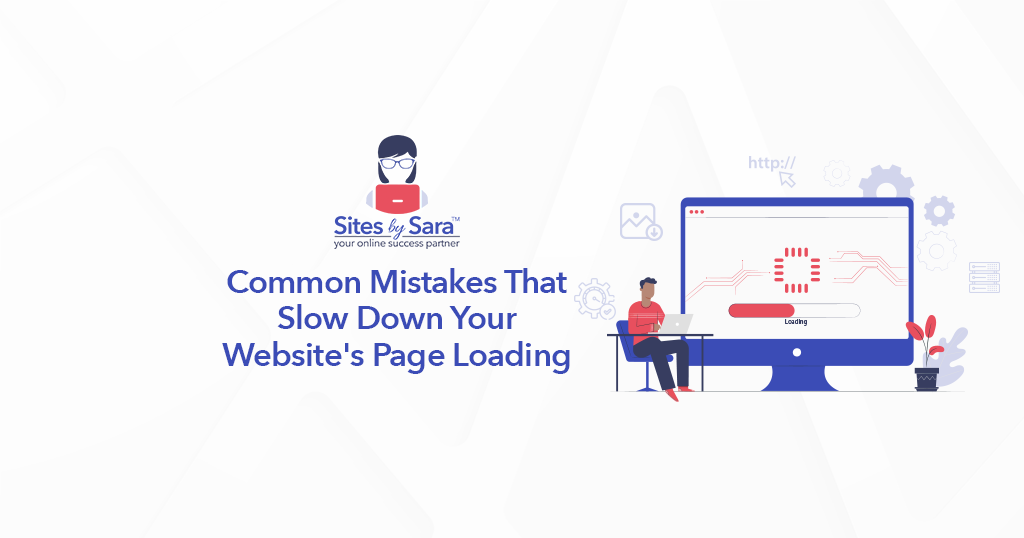Common Mistakes That Slow Down Your Website’s Page Loading

Your website’s loading speed isn’t just a technical metric; it’s a crucial factor that can make or break your online success. Picture this: a potential customer lands on your website, eager to explore your offerings, but frustration sets in as they’re met with sluggish loading times. In a split second, they hit the back button and move on to a competitor’s site. That’s the harsh reality of the digital world we live in today.
At Sites by Sara, we’re here to help you navigate through the maze of common mistakes that can significantly slow down your website’s page loading speed. From unoptimized images to poor hosting choices, we’ll delve into each aspect, providing actionable insights to ensure your website is blazing fast and ready to delight your visitors.
Understanding Page Loading Speed
Let’s start with the basics: what exactly is page loading speed? Think of it as the time it takes for your website to go from 0 to fully loaded in a user’s browser. We’re talking everything from images and text to fancy animations and interactive doodads. Studies show that if your site takes longer than a few seconds to load, visitors are more likely to bail faster than you can say “slowpoke.”
Now, why does it matter? Well, besides avoiding the dreaded back button, faster loading times can boost your search engine rankings and keep visitors coming back for more. After all, who wants to wait around for a sluggish site to load when there are speedier options just a click away?
Common Mistakes
Unoptimized Images
Alright, let’s talk about image optimization. We all love a good picture, but if those images aren’t optimized, they can weigh down your website like a ton of bricks. Oversized images can gobble up bandwidth and slow down loading times faster than rush hour traffic.
So, what’s the solution? Resize and compress those images like you’re Marie Kondo decluttering a closet. By trimming the fat and using modern image formats like WebP, you can keep your site sleek and speedy without sacrificing quality.
Excessive HTTP Requests
Next up, let’s tackle HTTP requests. Each time a user visits your site, their browser sends out a request for every little thing—images, scripts, stylesheets, you name it. But too many requests can clog up the works faster than a hairball in a drainpipe.
The fix? Streamline and consolidate those requests like you’re Marie Kondo organizing a junk drawer. Minify and combine CSS and JavaScript files, and consider asynchronous loading for non-essential scripts. By cutting down on the digital clutter, you’ll keep your site humming along smoothly.
Poor Hosting Choices
Now, onto hosting. Your choice of hosting provider can make a world of difference in your site’s performance. Think of it like choosing a home for your website—opt for a rundown shack, and you’ll be dealing with leaks and creaks galore.
Instead, invest in a reliable hosting provider like a sturdy brick house. Look for one that offers ample resources and top-notch support, so your site stays online and running smoothly 24/7. After all, you wouldn’t want your website to go MIA when you need it most, would you?
Lack of Caching Mechanisms
Caching is like having a super-efficient assistant who remembers everything so you don’t have to. Without caching, your website has to fetch the same resources over and over again, like Groundhog Day on repeat.
But with caching in place, those resources are stored locally, ready to be served up at lightning speed. It’s like having your favorite snack waiting for you in the pantry—no need to trek to the store every time you get a craving.
Mobile Optimization
Alright, let’s talk mobile. These days, everyone and their grandma are browsing the web on their smartphones. So if your site isn’t optimized for mobile, you’re missing out on a huge chunk of potential visitors.
Mobile optimization isn’t just about squishing your site onto a smaller screen—it’s about creating a seamless experience that’s tailored to mobile users’ needs. Think responsive design, fast loading times, and thumb-friendly navigation. After all, nobody wants to pinch and zoom their way around a clunky website.
Code Optimization
Last but not least, let’s clean up that code. Bloated, inefficient code is like a tangled mess of Christmas lights—it’s a nightmare to untangle and slows everything down.
So roll up your sleeves and get ready to declutter. Minify your HTML, CSS, and JavaScript files to cut down on excess baggage, and prioritize above-the-fold content to give users what they need ASAP. It’s like Marie Kondo-ing your website—spark joy and ditch the rest.
Content Delivery Networks (CDNs)
Ever wish your website could teleport? That’s where CDNs come in. By storing copies of your site’s content on servers all over the world, CDNs can zap your pages to users’ screens faster than you can say “Beam me up, Scotty.”
With a CDN in your corner, you can kiss goodbye to long loading times and hello to lightning-fast performance, no matter where your visitors are located. It’s like having a network of magical delivery drones—your content arrives in the blink of an eye, no matter the distance.
Browser Caching
Browser caching is like leaving a trail of breadcrumbs for your web browser to follow. Instead of fetching the same resources every time a user visits your site, browser caching lets them store copies locally for quick and easy access.
So go ahead, tell your browser to kick back and relax—it’s got all the resources it needs right at its fingertips. With browser caching in place, your site will load faster than you can say “Go, go, gadget browser!”
Compression Techniques
Compression is like packing your website into a tiny suitcase—it’s all about fitting as much as possible into a limited space. By compressing your files before sending them over the internet, you can shave precious milliseconds off your loading times.
So zip up those files and watch your website take off like a rocket. With compression techniques in place, you’ll leave slow loading times in the dust and zoom ahead to the finish line.
Reducing Server Response Time
Server response time is like the speed of light in the digital world—the faster, the better. A sluggish server can drag down your website’s performance faster than a boat anchor.
But with a little optimization, you can turn that tortoise into a hare. Fine-tune your server settings, optimize your code, and keep an eye on performance metrics like TTFB. Before you know it, your website will be sprinting ahead like Usain Bolt at the Olympics.
Regular Performance Monitoring
Monitoring your website’s performance is like taking your car in for a tune-up—it’s essential for keeping things running smoothly. Without regular check-ups, you might not notice those little hiccups until they turn into major breakdowns.
So keep an eye on those performance metrics, run regular tests, and be on the lookout for any red flags. With proactive monitoring in place, you can catch issues before they spiral out of control and keep your website running like a well-oiled machine.
Avoiding Redirects
Redirects are like detours on the information superhighway—they can send users on a wild goose chase and slow down your website in the process. Every redirect adds extra time and complexity to the loading process, like adding extra pit stops to a road trip.
So keep those redirects to a minimum and stick to the direct route. By avoiding unnecessary detours, you’ll keep your website running smoothly and get users to their destination faster than you can say “shortcut.”
External Scripts and Plugins
External scripts and plugins are like hitchhikers on your website—they can slow you down if you pick up too many. Each script adds extra baggage to your site’s load time, like lugging around a backpack full of rocks.
So be selective about which scripts and plugins you invite along for the ride. Stick to the essentials and keep things lean and mean. With fewer hitchhikers weighing you down, your website will zip along like a sports car on the open road.
Prioritizing Above-the-Fold Content
Above-the-fold content is like the opening act of a blockbuster movie—it sets the stage and hooks the audience from the get-go. But if your above-the-fold content takes too long to load, you’ll lose your audience faster than you can say “fade to black.”
So give your above-the-fold content the star treatment it deserves. Prioritize speed and performance to keep users engaged and coming back for more. After all, you only get one chance to make a first impression.
And there you have it—our guide to turbocharging your website for maximum performance. By avoiding common mistakes and optimizing your site for speed, you can keep visitors happy, boost your search engine rankings, and leave the competition in the dust.
So what are you waiting for? It’s time to rev up your website and leave slow loading times in the rearview mirror. With the right optimizations in place, you’ll be zooming ahead to online success in no time.
FAQs (Frequently Asked Questions)
- How does page loading speed affect SEO?
Page loading speed is a crucial ranking factor for search engines like Google. Faster-loading websites tend to rank higher in search results, leading to increased visibility, organic traffic, and potential customers.
- What are some tools for measuring page loading speed?
Popular tools for measuring page loading speed include Google PageSpeed Insights, GTmetrix, Pingdom Tools, and WebPageTest. These tools analyze various performance metrics and provide actionable recommendations for optimizing website speed and performance.
- What is the ideal page loading speed?
While there’s no one-size-fits-all answer, aiming for a page loading time of under three seconds is generally considered optimal for providing a good user experience and maximizing search engine rankings. However, factors such as website complexity, server performance, and network conditions can influence ideal loading times.
- How can I optimize images for faster loading?
You can optimize images for faster loading by resizing them to the correct dimensions, compressing them without sacrificing quality, and leveraging modern image formats such as WebP. Additionally, implementing responsive image techniques and lazy loading can further improve loading speed and efficiency.
- Why is mobile optimization important for page loading speed?
With the increasing prevalence of mobile browsing, optimizing websites for mobile devices is essential for delivering fast and seamless user experiences. Mobile optimization ensures that websites load quickly and display properly on smartphones and tablets, catering to the needs and preferences of mobile users.




